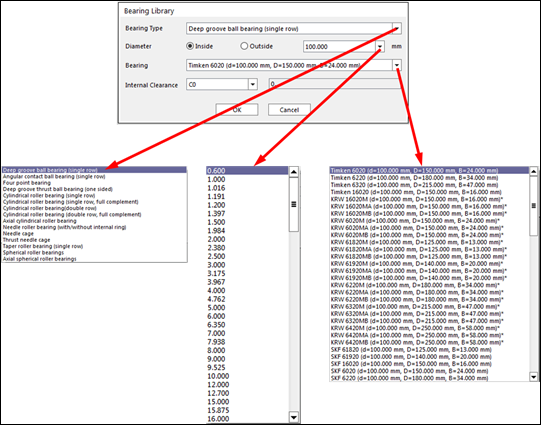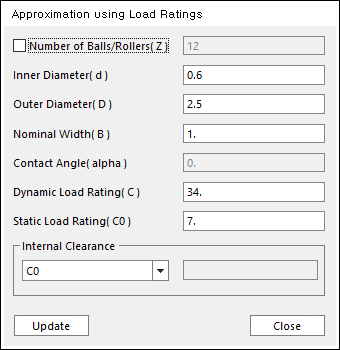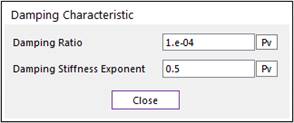

Figure 1 Properties of Bearing Group dialog box
•Center Point: Specify the center point of bearing group.
•Normal Direction: Specify the normal direction of bearing group.
•Bearing Library: User can define bearing properties by direct input or selecting bearing data base KISSsoft provide. If Bearing Library is selected, bearing properties below are defined automatically according to bearing library data. If User Input is selected, user has to set bearing type first. And then, input the bearing properties according to the bearing type.
Note
Generally bearing has retainer that holds the balls. Full Complement bearing removes this retainer and fit the additional balls which allows increases in bearing dynamic capacity.
In case of the bearing of asymmetric
shape as below, the behavior of the bearing depends on the Z axis
direction.
Angular contact ball bearing (single row)
Axial angular
contact roller bearing
Taper roller bearing (single row)
Axial spheriacal
roller bearing

Figure 2 Bearing Library
•Diameter: Select inside or outside diameter to classify bearings with this diameter condition.
•Bearing: Select a bearing that satisfies diameter condition from bearing list. If the label of the bearing has a "*" after the bracket (e.g. SKF 6008 (...) *), this means that the database contains at least one internal geometry value.
•Internal Clerance: Specify bearing internal clearance.
Note
If the bearing inner geometry is provided by the manufacturer, then it is used in the calculation. If it is unknown, then KISSsoft runs an approximation method that uses the bearing load ratings (both static C0 and dynamic C) provided by the manufacturer to calculate the internal geometry. This procedure is based on ISO 76 and ISO 281-4 and generates very useful results in general.
•Bearing Type: Select bearing type If User input is defined in Bearing Library. RecurDyn supports 15 bearing types from KISSsoft.
•Inner Diameter(Di): Inner diameter of the ball in the case of ball bearing.
•Outer Diameter(Do): Outer diameter of the ball In the case of ball bearing.
•Normal Width(B): Bearing width.
•Number of Balls/Rollers(Z): Number of rolling elements.
•Ball/Roller Diameter(Dw): Diameter of the rolling element(ball/roller).
•Reference Diameter(Dpw): Pitch dismeter of the rolling elements.
•Radius of Curvature, Inner Ring(ri): Raceway radius – inner(bearing dependent).
•Radius of Curvature, Outer Ring(ro): Raceway radius – outer(bearing dependent).
•Radius of Curvature, Roller(Rp): (Only for spherical bearings –axial,radial) Roller radius
•Axial Clearance: Axial clearance of the bearing. It is the total amount of free axial motion between a bearing's inner and outer race.
•Diametral Clearance: Diametral clearance of the bearing. It is the gap in a fixed outer ring between the upper and the lower position the inner ring can have without load.
•Contact Angle(alpha): Pressure angle. It is defined as the angle between the line that joins the ball contact points and the raceways in the radial plane along which the combined load is transmitted from one raceway to another, and a line that is perpendicular to the bearing axis.
•Effective Roller Length(Lwe): Roller length.
•Distance(Lwc): (Only for spherical bearings -axial) distance
•Row Distance(a): (Only for double row cylindrical) roller center line distance.
•Dynamic Load Rating(C): Dynamic load rating.
•Static Load Rating(C0): Static load rating.
•Approximation using Load Ratings: When the selected bearing dosen’t have inner geometry information, KISSsoft can calculate approximated internal geometry. If the users know more exact information, the user can modify and apply that.

Figure 3 Approximated Load Ratings dialog box
•Damping Characteristic: RD automatically calculate damping force using damping ratio and damping stiffness exponent with stiffness by bearing force. The relationship is as follows:

Eq.1 Equation of Damping Force

Figure 4 Damping Characteristic dialog box
•Damping Ratio: Propornational damping coefficient to the bearing stiffness.
Damping Stiffness Exponent: Damping exponent to the bearing stiffness.